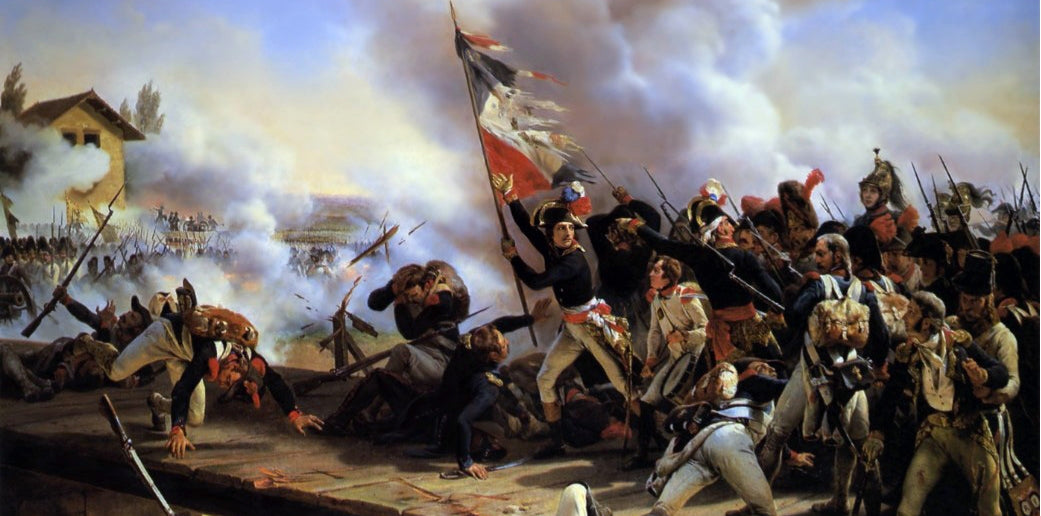We aim to provide regular historical content on our blog to educate visitors to our website about the Napoleonic era. We start off with a series introducing the seven anti-French coalitions between 1792-1815 which witnessed Napoleon's rise and eventual fall.
Napoleonic Impressions sells historical gifts inspired by the Napoleonic Wars. But what are the Napoleonic Wars? For almost a quarter of a decade between 1792 and 1815, the European continent was engulfed in unbroken warfare. This period of conflict is typically divided into the French Revolutionary Wars (1792-1802) and the Napoleonic Wars (1803-15), though the latter term is also used to refer to the whole conflict.
This three part series offers a very brief introduction to the seven anti-French coalitions which collectively made up the French Revolutionary and Napoleonic Wars. Part 1 covers the first two coalitions of the French Revolutionary Wars, Part 2 covers Napoleon’s greatest campaigns from the Third Coalition to the Fifth Coalition. Part 3 deals with Napoleon’s defeats against the Sixth and Seventh Coalitions.
This series does not cover other major conflicts such as the Peninsular War (1808-14) or the Russian campaign (1812), which do not fit into the categorisation of the seven coalitions. These separate campaigns will be covered in detail in future posts.
War of the First Coalition (1792-97)
The French Revolution of 1789 did not immediately lead to the outbreak of war in Europe. France remained a monarchy under King Louis XVI, though his powers were significantly curtailed. It was only in 1791 – when Louis and his entourage were caught at Varennes while attempting to escape – that the royal family was effectively placed under house arrest. This prompted Holy Roman Emperor Leopold II (the brother of Marie Antoinette, Queen of France) and King Frederick William II of Prussia to sign the Declaration of Pillnitz on 27 August 1791, where two parties denounced the Revolution and agreed to support the restoration of Louis XVI’s absolute powers.
Neither the Holy Roman Empire nor Prussia were keen on mobilizing their forces for war, and the Declaration served no purpose other than to alienate the French revolutionary government. In the spring of 1792, the revolutionary government pre-emptively declared war on Prussia and Austria, who were joined by Britain and Spain and a number of lesser powers in the First Coalition. This marked the outbreak of the French Revolutionary Wars. With an inexperienced army and a shortage of trained officers against the combined might of the rest of Europe, the French were expected to lose quickly.
The Duke of Brunswick led a Prussian army into France in July and made considerable progress towards Paris, but was defeated at the Battle of Valmy on 20 September. While Valmy was not a particularly large engagement in terms of scale, the French victory had huge symbolic value – demonstrating that an enthusiastic citizen army could defeat Europe’s most professionalised army. Emboldened by the victory, the revolutionaries deposed Louis a couple of days later and proclaimed the French Republic. King Louis and Queen Marie Antoinette were later executed in 1793.
In the following years, the French Revolutionary Army demonstrated that Valmy was no fluke. In 1794 the French occupied Belgium and the Rhineland. The following year French forces occupied the Netherlands, establishing the Batavian Republic – the first of several ‘sister republics’ which served as satellite states. In January 1795, the French cavalry had managed to achieve a rare feat in military history by capturing a Dutch fleet trapped by frozen ice while anchored at Den Helder. Meanwhile, young talented generals such as Jean Victor Marie Moreau, Jean-Baptiste Jourdan and Lazare Hoche rose rapidly through the ranks, as the republican government promoted officers by merit rather than seniority.
The War of the First Coalition also saw Napoleon Bonaparte establish his reputation. Serving as an artillery officer, he was instrumental in the successful siege of Toulon in 1793, which had been occupied by French Royalists supported by the British navy. In 1795, he commanded the Army of the Interior and supressed a Royalist uprising in Paris with ‘a whiff of grapeshot.’ In 1796, he was named commander of the Army of Italy at the age of 27.
During his first Italian campaign, Napoleon and his men exhibited the qualities which would define his style of warfare – quick manoeuvring, aggressive attacks, tactical genius on the battlefield. General Buonaparte – he would not drop the ‘u’ until later – won a series of brilliant victories against the Austrians at Lodi, Rivoli, and Arcole, where Buonaparte himself took the standard and rallied his men cross the bridge over the River Adige and attack the Austrians. Buonaparte’s victories forced the Austrians to sue for peace. Despite having no diplomatic authority, he duly negotiated an armistice at Leoben with the Holy Roman Empire in April. This was confirmed by the Treaty of Campo Formio in October, which saw France take control of Belgium, the Rhineland, and much of northern Italy, ending the first act of the French Revolutionary Wars.
War of the Second Coalition (1798-1802)
Britain and France remained at war despite Campo Formio. In the summer of 1798, General Buonaparte invaded Egypt in an effort to undermine British interests in the Mediterranean. On the way he seized the island of Malta, forcing out the Knights of St John. The Knights were the descendants of the crusading Order of St John of Jerusalem, and had established themselves in Malta in the 1600s. Faced with invasion by the godless French revolutionaries, they appealed to Tsar Paul I of Russia for protection. Over the ensuing months, Russia, Britain, Austria and the Ottoman Empire formed a Second Coalition in an effort to limit French expansion.
In 1799, the Second Coalition allies saw great success as an Austro-Russian army under the 69 year old Russian veteran Alexander Suvorov won a series of blistering victories in northern Italy at Cassano, Trebbia, and Novi, undoing Napoleon’s conquests in the process. However, disagreements between the Russians and Austrians, jealous of Suvorov’s success, forced Suvorov to cross the Alps to reinforce General Alexander Rimsky-Korsakov’s 30,000 men in Switzerland. Suvorov managed to keep his army intact, albeit with considerable losses, but by the time he arrived Korsakov had already been defeated at Zurich on 25 September by General André Massena – previously one of Napoleon’s lieutenants in the Italian campaign. The remnants of the Russian army returned to Russia, and Tsar Paul left the Second Coalition.
Meanwhile, after initial successes against the Mameluk rulers of Egypt, Napoleon’s army was losing strength and unable to overcome British-Ottoman forces in Syria. Unable to make progress and alerted to news of a political crisis in France, Napoleon abandoned his army and sailed to France. On 9 November 1799, 18 Brumaire in the French Republican Calendar, Napoleon – now spelling his name Bonaparte – took control of the French government in a coup and established the Consulate, inspired by the Roman Republic. In 1800 he ordered Moreau to take command of an army in Germany while he returned to northern Italy to take up the fight against the Austrians. At Marengo on 14 June 1800, he encountered the Austrians unexpectedly and was almost defeated before reinforcements led by General Louis Desaix (killed in the early stages of the assault) shifted the momentum and caused the Austrians to rout.
The victory at Marengo, together with Moreau’s victory at the Battle of Hohenlinden (3 December 1800) over Archduke Charles of Austria at the end of the year forced the Austrians to sue for peace. The ensuing Treaty of Lunéville effectively restated the terms of Campo Formio, albeit with some further Austrian concessions.
Meanwhile, in 1801 Henry Addington succeeded William Pitt the Younger as British prime minister. Addington favoured making peace with France, while Pitt had wanted to continue the war. While Britain’s allies in Europe had been comprehensively defeated, the Royal Navy managed to capture several lucrative colonies from the French and their allies. Napoleon dispatched his elder brother Joseph to negotiate with the British. The British sent Lord Charles Cornwallis, the same man who had been defeated at Yorktown in the American Revolutionary War. Negotiations were successful and the two parties signed the Treaty of Amiens in 1802, which saw Britain recognise most of France’s conquests in Europe and relinquishing most of the captured colonies, keeping only Trinidad and Ceylon (Sri Lanka), neither of which had been French possessions.
Although Europe did not know it at the time, the Treaty of Amiens marked the end of the French Revolutionary Wars. First Consul Napoleon Bonaparte would have far grander ambitions.
Did you enjoy reading about the French Revolutionary Wars and Napoleon Bonaparte’s rise to power? Check out this mug featuring a penguin design inspired by Antoine Jean Gros's painting Bonaparte at the Bridge of Arcole.

This article is part of a three part series on the seven anti-French coalitions. Here are the other parts:



Share and get 15% off!
Simply share this product on one of the following social networks and you will unlock 15% off!